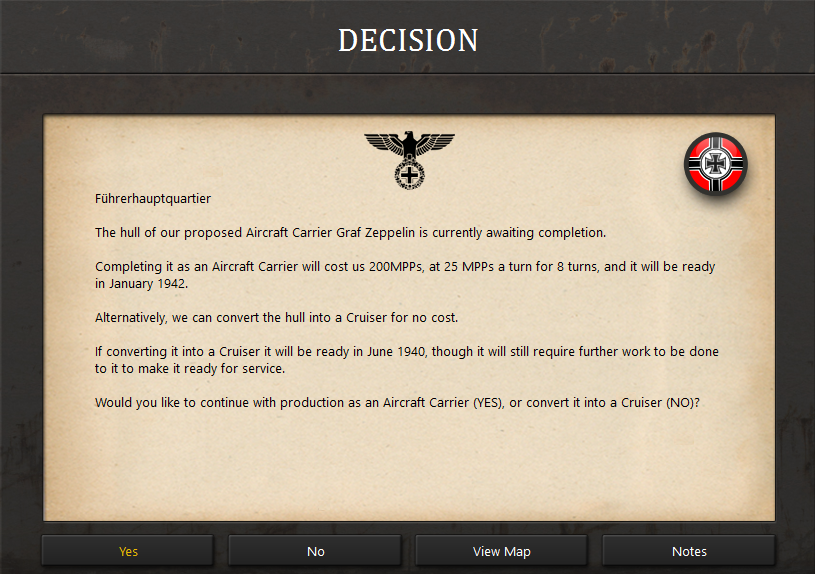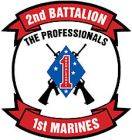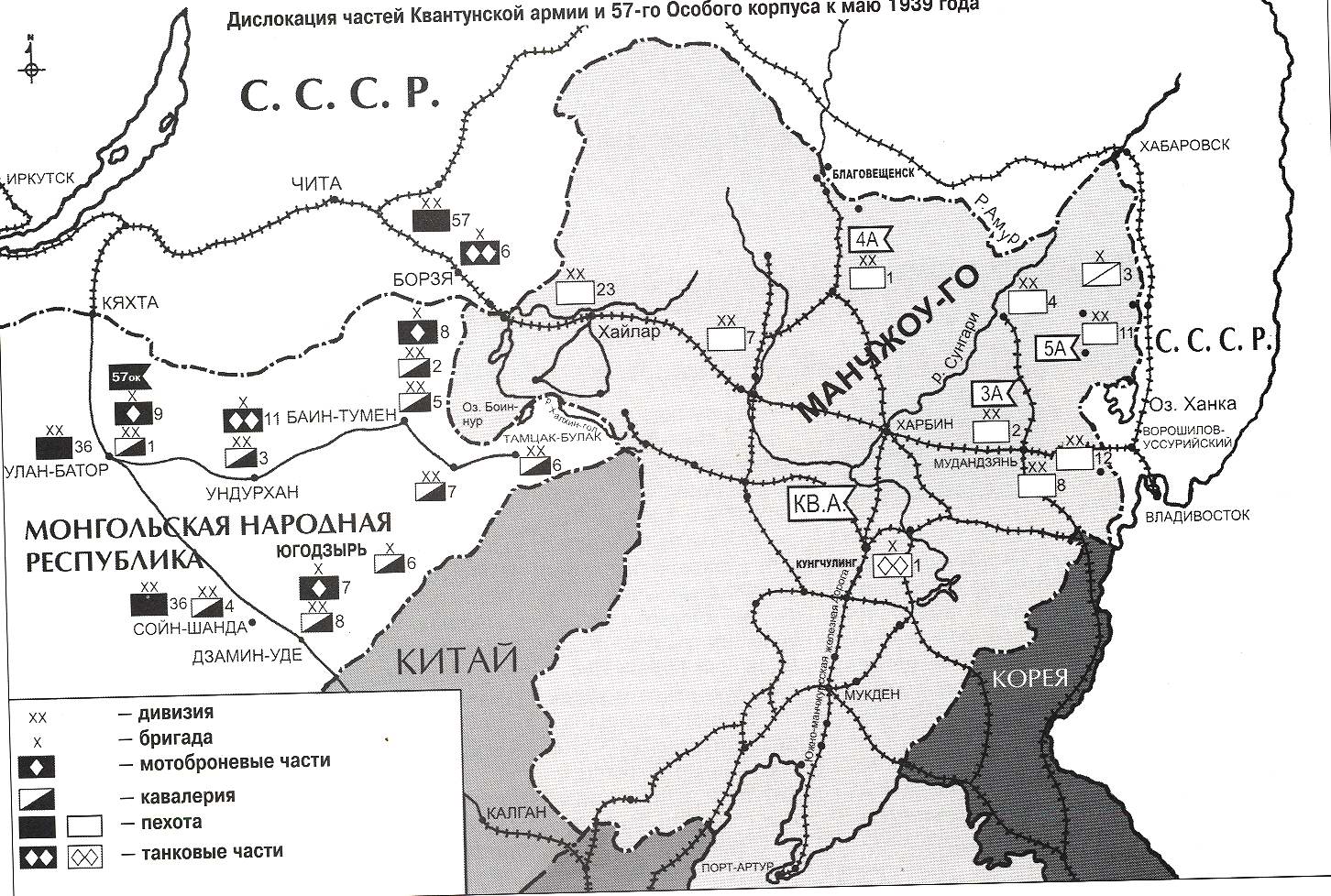EdwinP
Posts: 179
Joined: 2/20/2004
Status: offline

|
One mod that I am considering is a Manchuko/Mongolia/Siberia map region linked to the main map area by a single hex wide rail route. The rail route would be inactive until annexed by the Soviet Union. Thus preventing them from transfering units to the West. This region would have two neutrals countries - Russia Siberia and Japan. Both regions would become active if Japan decided to attack Russia. Russia could operate units to/from the Siberia map extension by paying the appropriate movement cost. They could also move units normally; however, due to the winding single hex wide route this would take several turns; longer in bad weather, for the unit to travel the 5,600 miles to Moscow. I would have to find references with the Japanese and Soviet OOB in the region and create a map at the same scale as the European map.
"In the summer of 1939, Soviet and Japanese armies clashed on the Manchurian-Mongolian frontier in a little-known conflict with far-reaching consequences. No mere border clash, this undeclared war raged from May to September 1939 embroiling over 100,000 troops and 1,000 tanks and aircraft. Some 30,000-50,000 men were killed and wounded. In the climactic battle, August 20-31, 1939, the Japanese were crushed. This coincided precisely with the conclusion of the German-Soviet Nonaggression Pact (August 23, 1939) Ė the green light for Hitlerís invasion of Poland and the outbreak of World War II one week later. These events are connected. This conflict also influenced key decisions in Tokyo and Moscow in 1941 that shaped the conduct and ultimately the outcome of the war."
Stalinís nightmare, to be avoided at all costs, was a two-front war against Germany and Japan. His ideal outcome would be for the fascist/militarist capitalists (Germany, Italy, and Japan) to fight the bourgeois/democratic capitalists (Britain, France, and perhaps the United States), leaving the Soviet Union on the sidelines, the arbiter of Europe after the capitalists had exhausted themselves. The Nazi-Soviet Pact was Stalinís attempt to achieve his optimal outcome. Not only did it pit Germany against Britain and France and leave the Soviet Union out of the fight Ė it gave Stalin the freedom to deal decisively with an isolated Japan, which he did at Nomonhan. This is not merely a hypothesis. The linkage between Nomonhan and the Nazi-Soviet Pact is clear even in the German diplomatic documents published in Washington and London in 1948. Recently revealed Soviet-era documents add confirming details.
Zhukov won his spurs at Nomonhan/Khalkhin Gol Ė and thereby won Stalinís confidence to entrust him with the high command in late 1941, just in time to avert disaster. Zhukov was able to halt the German onslaught and turn the tide at the gates of Moscow in early December 1941 (arguably the most decisive week of the Second World War) in part by deploying forces from the Soviet Far East. Many of these were the battle-tested troops he used to crush the Japanese at Nomonhan. The Soviet Far Eastern reserves Ė 15 infantry divisions, 3 cavalry divisions, 1,700 tanks, and 1.500 aircraft Ė were deployed westward in the autumn of 1941 when Moscow learned that Japan would not attack the Soviet Far East, because it had made an irrevocable decision for southward expansion that would lead to war with the United States.
But what if there had been no Nomonhan Incident, or if it had ended differently, say in a stalemate or a Japanese victory? In that case, the Japanese decision to move south might have turned out very differently. A Japan less impressed with Soviet military capability and faced with choosing between war against the Anglo-American powers or joining Germany in finishing off the U.S.S.R., might have viewed the northern course as the best choice.
If Japan had decided to attack northward in 1941, that could well have changed the course of the war, and of history. Many believe that the Soviet Union could not have survived a two-front war in 1941-1942. The Soviet margin of victory in the Battle of Moscow, and at Stalingrad a year later, was excruciatingly thin. A determined Japanese foe in the east might have tipped the balance in Hitlerís favor. Furthermore, if Japan had moved against the Soviet Union in 1941, it could not also have attacked the United States that year. The United States might not have entered the war until a year later, under circumstances in Europe far more unfavorable than the actual grim reality in the winter of 1941. How then would Nazi domination of Europe been broken?"
http://thediplomat.com/2012/08/the-forgotten-soviet-japanese-war-of-1939/
And Wikipedia Says:
Soviet Assessment
Following the battle, the Soviets generally found the results unsatisfactory, despite their victory. Though the Soviet forces in the Far East in 1939 were not plagued by fundamental issues to the same extent as those in Europe during the 1941 campaigns, their generals were still unimpressed by their army's performance. As noted by Pyotr Grigorenko, the Red Army went in with a very large advantage in technology, numbers, and firepower, yet still suffered huge losses, which he blamed on poor leadership.[12]
Although their victory and the subsequent negotiation of the Soviet-Japanese Neutrality Pact secured the Far East for the duration of the Soviet-German War, the Red Army always remained cautious about the possibility of another, larger Japanese incursion as late as early 1944. In December 1943, when the American military mission proposed a logistics base be set up east of Lake Baikal, the Red Army authorities were according to Coox, "shocked by the idea and literally turned white."[70] Due to this caution, the Red Army kept a large force in the Far East even during the bleakest days of the war in Europe. For example, on July 1 1942, Soviet forces in the Far East consisted of 1,446,012 troops, 11,759 artillery pieces, 2,589 tanks and self-propelled guns, and 3,178 combat aircraft.[71] Despite this, the Soviet operations chief of the Far Eastern Front, General A. K. Kazakovtsev, was not confident in his army group's ability to stop an invasion if the Japanese committed to it (at least in 1941-1942), commenting: ďIf the Japanese enter the war on Hitlerís sideÖ our cause is hopeless.Ē[72]
Japanese assessment and reforms
The Japanese similarly considered the result not a failing of tactics, but one that simply highlighted a need to address the material disparity between themselves and their neighbours.[73][74] They made several reforms as a result of this battle: Tank production was increased from 500 annually in 1939 to 1,200, a mechanized headquarters was established in early 1941, and the new Type 1 47 mm Anti-Tank Gun was introduced as a response to the Soviet 45mm. These cannons were mounted on Type 97 Chi-Ha tanks, resulting in the Type 97 ShinHoTo Chi-Ha ("New Turret") variant, which became the IJA's standard medium tank by 1942. IGHQ also dispatched General Tomoyuki Yamashita to Nazi Germany in order to learn more about tank tactics following the crushingly one-sided Battle of France and the signing of the Tripartite Pact. He returned with a report where he stressed the need for mechanization and more medium tanks. Accordingly, plans were put underway for the formation of 10 new armoured divisions in the near future.[75]
< Message edited by EdwinP -- 8/26/2016 7:53:05 AM >
|
 Printable Version
Printable Version













 Excellent portrayal of the possibilities that existed in the USSR - Japanese sphere of influence.
Excellent portrayal of the possibilities that existed in the USSR - Japanese sphere of influence. 

 New Messages
New Messages No New Messages
No New Messages Hot Topic w/ New Messages
Hot Topic w/ New Messages Hot Topic w/o New Messages
Hot Topic w/o New Messages Locked w/ New Messages
Locked w/ New Messages Locked w/o New Messages
Locked w/o New Messages Post New Thread
Post New Thread